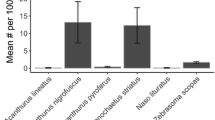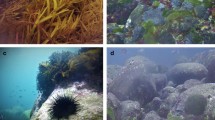Abstract
Paleontological and neontological studies suggest that stromatolite development may be limited to environments where ecological processes such as colonization (recruitment), growth, competition, and predation (herbivory) are low. We quantitatively tested this “ecological refuge paradigm” at a unique stromatolite-reef complex at Stocking Island, Bahamas where three contiguous zones grade in dominance from stromatolites in the back reef to a macroalgal turf in the reef flat to reef building corals and coralline algae and reef fishes in the fore reef. At two independent transects along this gradient, we quantified the distribution and abundance of the dominant organisms and measured the rates of the above-listed ecological processes and determined survival and growth of stromatolite, turf, and coralline algae transplanted to each of the three zones. We also measured both the sediment dynamics and temperature profiles along this gradient to determine if these may be controlling the ecological processes.
Stromatolites dominate the back reef zone where species diversity (especially among eukaryotes) and associated ecological pressures were low. Measured rates of colonization from calcified (i.e., coralline) and noncalcified macroalgae and filamentous turf algae were lowest in the back reef (i.e., <5% substrate colonization/y) and highest in the fore reef (95% substrate colonization/y). This suggests that competition for space was lowest in the stromatolite zone. Growth and survival rates of transplanted coralline algae were low in both the back reef (3 mm/y and 20–40% annual survival rates) and reef flat (<2 mm/y, 0% surviving) and highest in the fore reef (about 10 mm/y, 80% surviving). Foraging activity from all fishes was lowest in the back reef (total 0.4 bites/m2/h) and reef flat (0 bites/m2/h) and highest in fore reef (900–2200 bites/m2/h, mostly from omnivorous wrasses). Herbivory from all potential sources was below detectable levels in the stromatolite zone and was highest in the fore reef.
The ecological refuge found in the back reef stromatolite zone resulted primarily from periodic sediment inundation. Most eukaryotic reef-dwelling organisms cannot persist under as much as 700 mm of sediment for periods up to 100 days. Although the reef flat suffered both desiccation and thermal stress (averaging more than 5°C greater daily temperature fluctuation than the fore reef), natural and transplanted eukaryotic turf algae thrived there.
Although transplanted stromatolites survived best in the back reef (about 80% of the original transplant surviving/y), they also persisted in the fore reef (about 40% surviving per year). Therefore,Schizothrix-dominated stromatolites can persist in fore reef environments but because of the presence of other organisms and associated ecological pressures, their laminated microbial-produced structure is lost or obscured. While the sediment and the organisms necessary for stromatolite formation exist in this and probably in other modern reef environments, their reef-building contribution will be low except in unusual habitats where abiotic stresses maintain an ecological refuge.
Similar content being viewed by others
References
ABBOTT, D.P., OGDEN, J.C., ABBOTT, I.A., 1974, Studies on the activity pattern, behavior, and food of the echinoidEchinometra lucunter (Linneaus) on beachrock and algal reefs at St. Croix U.S.V.I. West Indies Laboratory Special Publication 4, 111 p.
ADEY, W.H. and STENECK, R.S., 1985, Highly productive eastern Caribbean reefs: synergistic effects of biological, chemical, physical, and geological factors, p. 162–187in Reaka, M.L., The ecology of Coral Reefs. v. 3, 208 p.
AWRAMIK, S.M., 1990, Stromatolites, p. 336–341in Briggs, D.E.G. and Crowther, P.R., Paleobiology: a synthesis. Blackwell Scientific Publications, Boston, MA, 583 p.
AWRAMIK, S.M., 1982, The origins and early evolution of life, p. 349–362in Smith, D.G., ed., The Cambridge Encyclopedia of Earth Sciences, Cambridge, Cambridge University Press, 496 p.
AWRAMIK, S.M. and RIDING, R., 1988, Role of algal eukaryotes in subtidal columnar stromatolite formation:Proceedings of the National Academy of Sciences (USA), v. 85, p. 1327–1329.
AWRAMIK, S.M., McMENAMIN, D.S., CHONGYU, YIN, ZIQIANG, ZHAO, QIXIU, DING, and SHUSEN, ZHANG, 1985, Prokaryotic and eukaryotic macrofossils from a Proterozoic/Phanerozoic transition in China:Nature, v. 315, p. 655–658.
CARPENTER, R.C., 1986, Partitioning herbivory and its effects on coral reef algal communities:Ecology, v. 56, p. 345–363.
COPPER, P., 1988, Ecological succession in Phanerozoic reef ecosystems: is it real?Palaios, v. 3, p. 136–152.
DETHIER, M.N., GRAHAM, E.S., COHEN, S., and TEAR, L., 1993, Visual versus random-print percent cover estimations: ‘objective’ is not always better:Marine Ecology Progress Series, v. 96, p. 93–100.
DILL, R.F., SHINN, E.A., JONES, A.T., KELLY, K., and STEINEN, R.P., 1986, Giant subtidal stromatolites forming in normal salinity water:Nature, v. 324, p. 55–58.
DONOVAN, S.K., 1989, Mass extinction: process and evidence. Columbia University Press, New York, 266 p.
GARRETT, P., 1970, Phanerozoic stromatolites: noncompetitive ecological restriction by grazing and burrowing animals:Science, v. 169, p. 171–173.
GOLUBIC, S., 1991, Modern stromatolites: a review, p. 541–561in Riding, R., ed., Calcareous algae and stromatolites. Springer-Verlag, Berlin, 571 p.
GROTZINGER, J.P., BOWRING, S.A., SAYLOR, B.Z., and KAUFMAN, A.J., 1995, Biostratigraphic and geochronologic constraints on early animal evolution:Science, v. 270, p. 598–604.
HATCHER, B.G., 1990, Coral reef primary productivity: a heirarchy of pattern and process:Trends in Ecology and Evolution, v. 5, p. 149–155.
HAY, M.E., 1984, Patterns of fish and urchin grazing on Caribbean coral reefs: are previous results typical?:Ecology, v. 65, p 446–454.
HAY, M.E., 1997, Calcified seaweeds on coral reefs: complex defenses trophic relationships, and value as habitats.In Proceedings of the 8th International Coral Reef Symposium Panana, 1045 p.
KAUFFMANN, E.G. and FAGERSTROM, J.A., 1993, The Phanerozoic evolution of reef diversity, p. 315–329in Ricklefs, R.E. and Schluter, D., eds., Species diversity in ecological communities. The University of Chicago Press, Chicago, 414 p.
LEWIS, S.M., 1986, The role of herbivorous fishes in the organization of a Caribbean reef community:Ecological Monographs, v. 56, p. 183–200.
LITTLER, M.M., LITTLER, D.S., and TAYLOR, P.R., 1995, Selective herbivore increases biomass of its prey: a chiton-coralline reef-building association:Ecology, v. 76, p. 1666–1681.
MACINTYRE, I.G., REID, R.P., and STENECK, R., 1996, Growth history of stromatolites in a Holocene Reef, Stocking Island, Bahamas:Journal of Sedimentary Research, v. 66, p. 231–242.
MONTY, C.L.V., 1973, Precambrian background and Phanerozoic history of stromatolitic communities, an overview:Annales de la Société Géologique de Belgique, v. 96, p. 585–624.
PARKER, B.C., WHARTON, R., SIMMONS, G.M. Jr., LOVE, F.G., SEABURG, K.G., and WHARTON, R.A., Jr., 1981, Modern stromatolites in Antarctic Dry Valley lakes:BioScience, v. 31, p. 656–661.
PAUL, V.J., 1997, Secondary metabolites and calcium carbonate as defenses of calcareous algae on coral reefs.In Proceedings of the 8th International Coral Reef Symposium Panama, 1045 p.
PINCKNEY, J.L. and REID, R.P., 1997, Productivity and community composition of stromatolitic microbial mats in the Exuma Cays, Bahamas:Facies, v. 36, p. 204–207.
PINCKNEY, J., PAERL, H.W., REID, R.P., and BEBOUT, B., 1995, Ecophysiology of stromatolitic mats. Stocking Island, Exuma Cays, Bahamas:Microbial Ecology, v. 29, p. 19–37.
PITLIK, T.J. and PAUL, V.J., 1997, Effects of toughness, calcite level and chemistry of crustose coralline algae (Rhodophyta, Corallinales) on grazing by the parrotfishChlorurus sordidus. In Proceedings of the 8th International Coral Reef Symposium Panama, 1045 p.
REID, R.P. and BROWNE, K.M., 1991, Intertidal stromatolites in a fringing Holocene reef complex in the Bahamas:Geology, v. 19, p. 145–156.
REID, R.P., MACINTYRE, I.G., BROWNE, K.M., STENECK, R.S., and MILLER, T., 1995, Modern marine stromatolites in the Exuma Cays Bahamas: Uncommonly Common:Facies, v. 33, p. 1–18.
RIDING, R., 1991, Classification of microbial carbonates, p. 21–51in Riding, R., ed., Calcareous algae and stromatolites. Springer-Verlag, Berlin, 571 p.
RODGERS, C.S., GILNACK, M. and FITZ, H.C., 1983, Monitoring of coral reefs with linear transects: a study of storm damage:Journal of Experimental Marine Biology Ecology, v. 66, p. 285–300.
SCHUBERT, J.K. and BOTTJER, D.J., 1992, Early triassic stromatolites as post-mass extinction disaster forms:Geology, v. 20, p. 883–886.
SOJA, C.M., 1994, Significance of Silurian stromatolite-sphinctozoan reefs: Reply:Geology, v. 22, p. 1051–1052.
STENECK, R.S., 1983, Escalating herbivory and resulting adaptive trends in calcareous algae:Paleobiology, v. 9, p. 45–63.
STENECK, R.S., 1986, The ecology of coralline algal crusts: convergent patterns and adaptive strategies:Annual Review Ecology and Systematics, v. 7, p. 273–303.
STENECK, R.S., 1988, Herbivory on coral reefs: a synthesis. Proceedings of the 6th International Coral Reef Symposium, Australia, v. 1, p. 37–49.
STENECK, R.S., 1994, Is herbivore loss more damaging to reefs than hurricanes? Case studies from two Caribbean reef systems (1978–1988). p. 220–226in Ginsburg, R.N., ed., Proc Colloquium on Global Aspects of Coral Reefs: Health, Hazards, and History, 1993, Rosenstiel School of Marine and Atmospheric Science, University of Miami, Miami, Florida, 420 p.
STENECK, R.S., 1997, Crustose corallines, macroalgae, herbivores, and sediments: complex interactions along productivity gradients.In Proceedings of the 8th International Coral Reef Symposium Panama, 1045 p.
STENECK, R.S. and DETHIER, M.N., 1994, The structure of algal-dominated communities: a functional group approach:Oikos, v. 69, p. 476–498.
STENECK, R.S., MACINTYRE, I.G., and REID, R.P., 1997, Unique algal ridge system of Exuma Cays, Bahamas:Coral Reefs, v. 16, p. 27–35.
VADAS, R.L. and STENECK, R.S., 1988, Zonation of deep water benthic algae in the Gulf of Maine:Journal of Phycology, v. 24, p. 338–346.
WALTER, M.R. and HEYES, G.R., 1985, Links between the rise of the Metazoa and the decline of stromatolites:Precambrian Research, v. 29, p. 149–174.
WALTER, M.R., 1983, Archean stromatolites: evidence of the Earth's earliest benthos.In Schopf, J.W., ed, Earth's Earliest Biosphere, it's origin and evolution. Princeton University Press, Princeton, NJ, p. 187–213.
WARD, D.M., WELLER, R., SHIEA, J., CASTENHOLZ, R.WS., and COHEN, Y., 1989, Hot spring microbial mats: anoxygenic mats of possible evolutionary significance.In Cohen, Y. and Rosenberg, E., eds., Microbial Mats, Washington:American Society of Microbiology, p. 3–15.
WHITTLE, G.L., KENDALL, C.G.St.C., DILL, R.F., and ROUCH, L., 1993, Carbonate cement fabrics displayed: a traverse across the margin of the Bahamas Platform near Lee Stocking Island in the Exuma Cays:Marine Geology, v. 110, p. 213–243.
Author information
Authors and Affiliations
Rights and permissions
About this article
Cite this article
Steneck, R.S., Miller, T.E., Reid, R.P. et al. Ecological controls on stromatolite development in a modern reef environment: A test of the ecological refuge paradigm. Carbonates Evaporites 13, 48–65 (1998). https://doi.org/10.1007/BF03175434
Published:
Issue Date:
DOI: https://doi.org/10.1007/BF03175434




